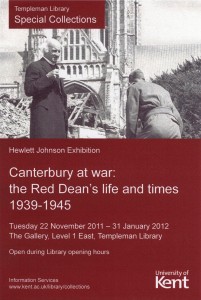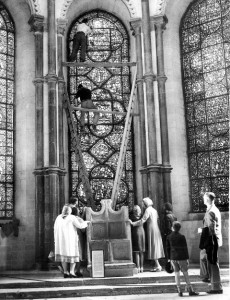 Last time, I announced the exciting news that the Templeman Library Gallery will be hosting an exhibition of materials from the Hewlett Johnson Papers, called ‘Canterbury at War: the Red Dean’s Life and Times, 1939-1945‘. The exhibition will open at 5.30pm on 22nd November and at 6pm John Butler, author of ‘The Red Dean: The Public and Private Faces of Hewlett Johnson‘, will talk about his experiences of mining the archive and show some of the gems which he found along the way. Everyone is welcome, and we would be delighted for you all to experience some of our exciting collections.
Last time, I announced the exciting news that the Templeman Library Gallery will be hosting an exhibition of materials from the Hewlett Johnson Papers, called ‘Canterbury at War: the Red Dean’s Life and Times, 1939-1945‘. The exhibition will open at 5.30pm on 22nd November and at 6pm John Butler, author of ‘The Red Dean: The Public and Private Faces of Hewlett Johnson‘, will talk about his experiences of mining the archive and show some of the gems which he found along the way. Everyone is welcome, and we would be delighted for you all to experience some of our exciting collections.
Well, with that advertisement completed, I can give you an update about all of the work we’ve been doing to prepare for this exhibition since last week. As you will have noticed (and our team cannot escape it), it’s only one week until we unveil our first major exhibition using Special Collections material for two years. So, with a little panicking and nervousness along the way, we are now in the final stages of putting the exhibition together.
The first thing which we had to do was put together a narrative. This was ably provided by Steve Holland, Head of Special Collections, after close reading of John’s book. The exhibition will explore Canterbury’s experience of the second world war through the eyes of the Johnsons, tracing the isolation and alienation which Hewlett experienced during the late 1930s (including the infamous Canons’ letter to The Times), through the Canterbury Blitz of May 30th-June 1st 1942, encountering more cheerful events such as the enthronement of William Temple as Archbishop in April 1942 and concluding with VE day in 1945, which Hewlett spent in Russia.

Canons' letter to the Times, 1940
Armed with Steve’s captions which pick out key events during this period, Chris, Hazel and I have trawled the archive to find relevant sources which can illustrate the Johnsons’ family and public life throughout this time. The first and most obvious sources were the wartime letters which Hewlett and his wife Nowell sent to each other. During the war, Nowell and their daughter Kezia were evacuated to Harlech; their second daughter, Keren, was born in Harlech in 1942. They usually wrote at least once a day, often more, and their letters vividly illustrate the challenges not only of living in Canterbury during this time but also of being so far apart. Their correspondence was especially heartfelt at Christmas, with Hewlett writing to Nowell ‘Kez will be playing with her doll and cradle now and tomorrow will be asking for more Christmas!’ on Christmas day of 1941. A year later, on 26th December 1942, Hewlett wrote ‘Christmas Day is over and I’m glad’.The wartime correspondence also gives some excellent descriptions of the bombing raid of May/June 1942, life in the bombed out Deanery and the food parcels which were sent from Wales to Kent and vice versa.

Removal of the stained glass from Canterbury Cathedral, 1939
With Chris exploring and transcribing the wartime letters (Hewlett’s handwriting can be challenging at the best of times), we have also been looking at visual statements of Canterbury during the war and its aftermath. Perhaps most dramatic are the images of preparation for war in 1939, when all of the stained glass was removed from the Cathedral windows and tonnes of soil spread over the nave and quire to protect those sheltering in the crypt from bombing raids. It’s also staggering to see the extent of the damage which Canterbury sustained during the ‘Canterbury Blitz’: one image shows the entire High Street in ruins, with the only feature still recognisable today being St George’s clock tower.
Now that we have all of our materials selected, the major task is to digitise, frame and prepare for exhibiting. We hope to put larger copies of the photographs on the walls, and to frame some of the cuttings, correspondence and other materials. We have 8 cases to play with, and are now in the final stages of confirming the layout.
All in all, there’s still lots to get done, but everyone I’ve mentioned it to (an I’ve mentioned it quite a lot, believe me) has been intrigued – none more so than those standing by the printer when the photographs are printed out! So we look forward to showing off one of our most personal and important collections and hope that you will all enjoy exploring the archive as much as we have enjoyed putting this exhibition together.
I wonder how we will cope once it’s all over….





